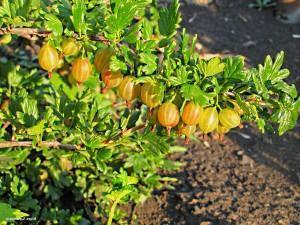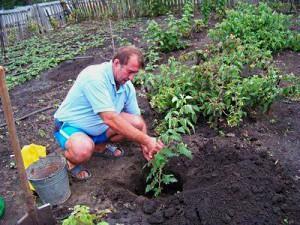When to plant gooseberries?
 Many summer residents grow gooseberries on their own in their backyard. But those who decided to do this for the first time are interested in the question: how, where and when it is better to plant gooseberries.
Many summer residents grow gooseberries on their own in their backyard. But those who decided to do this for the first time are interested in the question: how, where and when it is better to plant gooseberries.
Gooseberry belongs to not picky plants, it does not require special care, bears fruit well. But when growing it, to get large fragrant berries, you still need to follow some rules. If you choose the right place for planting and give the plant everything you need, then the gooseberry bush can successfully bear fruit for up to 50 years, and, at the same time, give up to 10 kg of harvest.
When and how to plant?

Gooseberries can be planted both in autumn and spring. But when is the best time to plant gooseberries in spring or autumn?
Most gardeners claim that planting gooseberries in the fall is much more effective. The best period for this is the end of September and the first decade of October.
The root system of the plant manages to get stronger and take root before the onset of cold weather, and in the spring the bush begins to develop rapidly. If we talk about spring planting, then it is very important not to be late. Planting should be done while the plant is calm.
Since the buds of the gooseberry bloom very early, the planting procedure must be completed before the beginning of April. But it should be remembered that plant survival after spring planting is much worse.
 How to plant gooseberries in autumn?
How to plant gooseberries in autumn?
Before planting gooseberries, you must cut the shoots short. Weak ones are removed completely. You need to choose 2-3 strong twigs and cut them so that there are several buds (about 3-4). If the root system is too long (about 25 cm or more) and interferes with planting, then it can also be cut a little. The need to trim and remove excess shoots is to ensure good nutrition for the plant in the spring.
If you leave many long twigs, they will begin to develop very strongly and quickly in the spring, and the root system weakened during transplantation will not be able to provide adequate nutrition for good growth of the bush.
Thus, the leaves and flowers will be weak and may dry out, as a result of which the growth and fruiting of the gooseberry will dull.
The soil for planting shrubs must be dug up at the beginning of September, chopped up all lumps and removed weeds. Next, pits are dug, the size of which should correspond to the root system. Often their depth is about 35-40 cm, and their diameter is about 50 cm. When digging a hole, the top layer of soil, which is rich in nutrients, is separated from the lean one, located a little deeper.
 When the pits are ready, they need to be fertilized. To do this, prepare a mixture of two-thirds of the top fertile soil, 10 kg of compost and 200 g of mineral fertilizer (superphosphate and potassium salt). The hole is filled in half with the mixture, and the remaining third of the earth is poured with a tubercle in the middle. In this form, the pits are left for several weeks, this gives the earth the opportunity to sink.
When the pits are ready, they need to be fertilized. To do this, prepare a mixture of two-thirds of the top fertile soil, 10 kg of compost and 200 g of mineral fertilizer (superphosphate and potassium salt). The hole is filled in half with the mixture, and the remaining third of the earth is poured with a tubercle in the middle. In this form, the pits are left for several weeks, this gives the earth the opportunity to sink.
After the expiration of time, each seedling must be placed in a mound vertically, or slightly inclined, spread the roots and sprinkle with earth.The root collar of the seedling goes deep into the ground by about 4-5 cm. The soil around the bush must be tamped, watered abundantly and mulched with humus. It is best to plant on a cloudy and windless day, this contributes to better plant survival.
Where to plant gooseberries?
 In order for the bushes to grow well and bear fruit, before planting, you need to find out where it is best to plant gooseberries.
In order for the bushes to grow well and bear fruit, before planting, you need to find out where it is best to plant gooseberries.
It should be remembered that gooseberries are a heat-loving shrub. Therefore, when choosing a place for landing, you need to make sure that the site is flat, lighted and windless. Groundwater should not be closer than 1.5 meters to the surface of the earth. If the soil under the gooseberry is constantly wet, swampy, then the plant, after a while, will die.
Do not use raspberry or currant area to plant gooseberries. These plants are very depleting of the soil, and, in addition, they can contain pests and diseases common to these plants.
You need to pay attention to the fact that after a few years the gooseberry bushes grow very much. Therefore, it is necessary to maintain a distance when landing. Often the best option is the distance between the gooseberry bushes of 1 and 2 meters (provided that the bushes are planted in rows).
 Often, if the garden plots are small, the owners cannot determine where to plant the gooseberries. In this case, it can be placed along the fence. But you need to remember that bushes are planted no closer than 1.5-2 meters before the fence. The plant will feel good between small fruit trees, but the distance (1-1.5 m) is also important here.
Often, if the garden plots are small, the owners cannot determine where to plant the gooseberries. In this case, it can be placed along the fence. But you need to remember that bushes are planted no closer than 1.5-2 meters before the fence. The plant will feel good between small fruit trees, but the distance (1-1.5 m) is also important here.
Make sure that the soil around the bush is loose and free of weeds. During the fruiting period, you need to water the plant well.